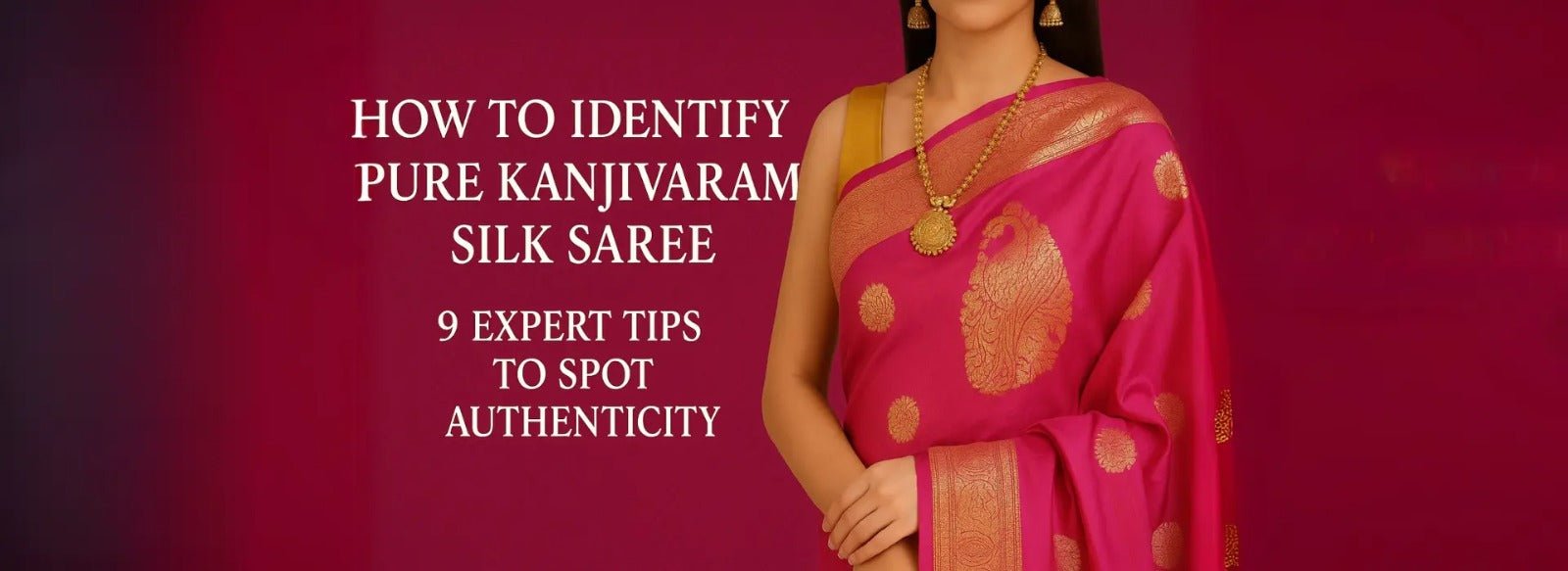Table of Contents
Introduction: The Magnificent Kanjivaram Saree
The Kanjivaram, or Kanjeevaram silk saree, is often called the "queen of silks." Originating from Kanchipuram in Tamil Nadu, these sarees blend tradition, luxury, and fine craftsmanship. A pure Kanjivaram saree is a treasure — but with machine-made copies flooding the market, knowing how to identify a pure Kanjivaram silk saree is more critical than ever.
Let's dive into simple, expert tips to ensure you bring home an authentic piece of heritage!
What Makes a Kanjivaram Saree So Special?
Before spotting authenticity, it's essential to know what makes a Kanjivaram saree so exceptional:
-
Handwoven Excellence: Skilled weavers spend weeks creating one saree.
-
Durability: Known to last decades if maintained well.
-
Rich Colors and Motifs: Inspired by temples, nature, and scriptures.
-
Zari Work: Made with real silver or gold thread.
1. Check the Fabric: Lustrous and Heavy
A pure Kanjivaram silk saree will have a natural sheen and feel smooth yet thick when you touch it. It won't be overly shiny like artificial silk.
-
Pure silk has a soft, luxurious feel.
-
Imitation silk feels overly slippery and looks flashy.
Look for a soft gloss that reflects light subtly — not harshly.
2. Look at the Weave: Separate Body and Border
One classic trademark of an authentic Kanjivaram is that the body and border are woven separately and then interlocked so seamlessly that they appear as one.
If you carefully examine where the border meets the body, you should notice a slight joint or a zig-zag pattern, known locally as the pitni.
Machine-made sarees won't have this distinctive feature.
3. Examine the Zari: Pure Silver and Gold Zari
Authentic Kanjivaram sarees use pure zari silver threads dipped in gold. To test:
-
Scratch lightly under the zari threads.
-
If a reddish thread appears, it's pure zari.
-
If a white or dull thread appears, it's an imitation zari.
Pure zari adds weight and grandeur to the saree — one of its standout features!
4. Feel the Weight: Heavier than Regular Sarees
Kanjivaram sarees are noticeably heavier than other silks because of the pure mulberry silk and genuine zari work.
Even simple-looking designs will have a substantial weight compared to power loom or artificial silk versions.
5. Inspect the Motifs: Traditional and Detailed
Traditional Kanjivaram motifs include:
-
Peacocks
-
Temple borders
-
Checks
-
Elephants
-
Mythological scenes
If the motifs look overly modern, minimalistic, or lack detail, the saree might not be an authentic Kanjivaram.
Don’t Miss This : Handwashing vs. Dry Cleaning: The Right Way to Care for Silk Sarees
6. Conduct the Touch Test: Soft Yet Firm
Authentic Kanjivaram silk feels firm yet soft between your fingers. It shouldn't feel too flimsy or too stiff.
When you scrunch the fabric lightly, you should hear a soft, crisp sound — a typical indicator of pure silk.
7. The Burn Test (Only if Allowed)
If you're unsure and the seller permits:
-
Pull a small thread from the saree's underside.
-
Burn it carefully.
-
Pure silk smells like burnt hair and turns into a powdery ash.
-
Artificial silk smells like plastic and forms an intricate black bead.
Note: Only perform this with utmost caution and preferably with professional assistance!
8. Check for Silk Mark Certification
The Silk Mark is a government-authorized certification guaranteeing the purity of silk.
Always ask for sarees with a Silk Mark label for peace of mind.
9. Price Matters: Authenticity Comes at a Cost
If a Kanjivaram saree is priced unusually low (say, ₹3000–₹5000), it's most likely fake.
Pure Kanjivaram sarees usually start at ₹10,000 and can go up to several lakhs depending on the zari and craftsmanship.
Authentic beauty never comes cheap!
Don’t Miss This : Mixing Tradition with Trend: Indo-Western Looks with Silk Sarees
FAQs About Kanjivaram Silk Sarees
1. What is the price range of a pure Kanjivaram saree?
A genuine Kanjivaram silk saree typically ranges from ₹10,000 to ₹1,50,000 or more based on the zari content and weaving intricacy.
2. How do I maintain a pure Kanjivaram saree?
Dry clean only. Always store the saree in a muslin cloth and refold it every 3–6 months to avoid permanent creases.
3. Can I buy pure Kanjivaram sarees online?
Yes, but only from reputed stores or certified weavers. Always look for Silk Mark certification when buying online.
4. What are the most popular Kanjivaram motifs?
Peacocks, checks (kattam), temples (gopuram), chariots, and lotuses are among the most loved motifs in Kanjivaram sarees.
5. How is Kanjivaram silk different from Banarasi silk?
Kanjivaram uses heavier silk and richer zari work. Banarasi silk has finer, delicate weaving patterns with Mughal-inspired designs.
6. How can I identify fake zari?
Scratch the zari gently — if you see a reddish silk thread inside, it's pure. If you see a white polyester thread, it's fake.
Cherish the Heritage of Kanjivaram
Owning a pure Kanjivaram silk saree is like owning a piece of India's timeless tradition and artistry. When you choose wisely, you're not just buying fabric but preserving centuries of culture and craftsmanship.
So, next time you're dazzled by a beautiful saree, remember these tips to identify the true magic of Kanjivaram!
Curious What Everyone’s Reading? Take a Look!
Top 5 Designer Cotton Saree Trends You Need to Look for in 2025.
How to Style Your Organza Saree for Any Occasion.
5 Must-Have Cotton Saree Styles for Every Modern Woman.
Organza vs. Silk: Which Saree is Right for Your Special Occasion?


